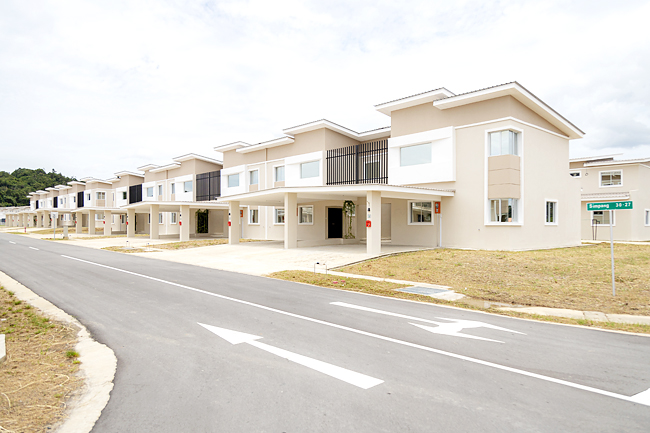In the grand mosaic of human existence, housing is what binds together the elements of security, stability and identity. More than a mere collection of bricks and mortar, a home is a haven where dreams are nurtured, and the tumult of the outside world fades into the background.
It is within these walls that people build their lives, foster connections and cultivate a sense of belonging. Housing goes beyond its physical form, serving as a vital pillar of our social fabric that influences everything from mental well-being to economic prosperity.
Recognising the deep-rooted significance of home ownership within the Sultanate, the National Housing Scheme (RPN) stands as a cornerstone of the Government of His Majesty Sultan Haji Hassanal Bolkiah Mu’izzaddin Waddaulah ibni Al-Marhum Sultan Haji Omar ‘Ali Saifuddien Sa’adul Khairi Waddien, Sultan and Yang Di-Pertuan of Brunei Darussalam’s visionary agenda. This initiative not only addresses the vital need for secure and stable living conditions but also underscores a broader commitment to enhancing the overall well-being of the nation’s people.
By prioritising housing as a central element of its development strategy, the government is forging a path towards a more prosperous and harmonious society, where every citizen has the opportunity to thrive within their own cherished home.
VISIONARY FOUNDATIONS
The roots of this initiative stretch back to the early 1950s, during the reign of Al-Marhum Sultan Haji Omar ‘Ali Saifuddien Sa’adul Khairi Waddien ibni Al-Marhum Sultan Muhammad Jamalul Alam, a visionary leader who laid the groundwork for resettlement policies that would transform the landscape of Brunei.

These early policies sought to move the residents of Kampong Ayer to more sustainable land areas, aiming to provide not only new land ownership but also opportunities for agricultural development to support their daily needs.
In 1952, the establishment of the Jabatan Perpindahan Kampong Ayer ke Darat – later renamed the Housing Development Department- marked the beginning of a series of National Housing Plans, now known as the National Housing Scheme.
One of the first significant relocations saw residents from Kampong Pengiran Bendahara Lama moving to RPN Kampong Bunut in Mukim Kilanas, setting the stage for a transformative journey towards a more stable and prosperous future.
In the years that followed, the Housing Development Department orchestrated a series of significant relocations, further shaping Brunei’s landscape.
In 1953, the department managed the resettlement of several kampongs, including Burong Pingai Berakas, Pancha Delima, Pengiran Siraja Muda, Anggerek Desa and Orang Kaya Besar Imas, all in Mukim Berakas.
The momentum continued into 1954 with the inclusion of Kampong Jaya Setia and Kampong Jaya Bakti, also within Mukim Berakas, marking another pivotal chapter in the country’s evolving housing narrative.
FROM RELOCATION TO DEVELOPMENT
To ensure the effective implementation of the housing programme, the Relocation Department (Jabatan Perpindahan) was established in 1970.
As the resettlement efforts gained momentum and demonstrated success, a nationwide survey was conducted in 1976 to gauge public interest in the scheme, particularly among those seeking home ownership. This pivotal survey laid the groundwork for the introduction of the National Housing Scheme, reflecting the government’s commitment to expanding and refining its resettlement initiatives.
The establishment of the Housing Development Department in August 1984 marked a significant upgrade from the Relocation Department.
Now a vital arm of the Ministry of Development, this department is entrusted with the planning, design, and maintenance of National Housing Schemes.
This evolution underscores the government’s dedication to continually enhancing housing opportunities and improving living standards for its citizens.
This initiative reflects His Majesty’s deep concern for the well-being of the people and aligns with Brunei Vision 2035, which aims to elevate the quality of life and living standards across the nation.
Since its inception in the 1950s, the National Housing Scheme has made remarkable strides, with the Housing Development Department successfully completing 31,145 houses and land lots by July 2024.
This achievement highlights the scheme’s profound impact and the ongoing commitment to fostering a prosperous and well-housed Brunei. A standout recent achievement for the Sultanate is the completion of the national housing terrace units in Kampong Lugu Phase 2.
As of May 25, this ambitious project has delivered 1,000 terrace houses across a sprawling 165 hectares.
GREEN LIVING
These modern homes come with essential infrastructure, including electricity, water supply, and well-paved roads. Embracing the ‘green building’ concept, the development aligns with the government’s Green Protocol, which aims to champion sustainability and minimise the nation’s carbon footprint.
Each terrace unit boasts a generous floor area of 122.42 square metres, featuring four bedrooms, a spacious living room, a kitchen, a dining area, a utility room, and three bathrooms. This thoughtful design not only ensures comfort and practicality but also supports a sustainable lifestyle, reflecting Brunei’s commitment to accommodating its growing population while safeguarding the environment.
Under His Majesty’s visionary leadership, the Sultanate continues to prioritise the well-being and quality of life for its citizens. The National Housing Scheme is a testimony to this dedication, providing comfortable, affordable, and eco-friendly homes that enhance the lives of Bruneians. – Rokiah Mahmud






